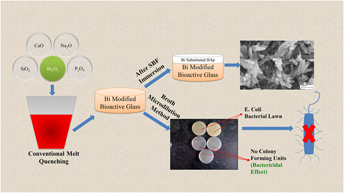Crossref Citations
This article has been cited by the following publications. This list is generated based on data provided by
Crossref.
Esfahani, Hamid
Darvishghanbar, Mahsa
and
Farshid, Behzad
2018.
Enhanced bone regeneration of zirconia-toughened alumina nanocomposites using PA6/HA nanofiber coating via electrospinning.
Journal of Materials Research,
Vol. 33,
Issue. 24,
p.
4287.
Prasad S., Sakthi
Datta, Susmit
Adarsh, Tarun
Diwan, Prerna
Annapurna, K.
Kundu, Biswanath
and
Biswas, Kaushik
2018.
Effect of boron oxide addition on structural, thermal, in vitro bioactivity and antibacterial properties of bioactive glasses in the base S53P4 composition.
Journal of Non-Crystalline Solids,
Vol. 498,
Issue. ,
p.
204.
Prasad, Sakthi
Gaddam, Anuraag
Jana, Anuradha
Kant, Shashi
Sinha, P. K.
Tripathy, Sucheta
Annapurna, K.
Ferreira, José M. F.
Allu, Amarnath R.
and
Biswas, Kaushik
2019.
Structure and Stability of High CaO- and P2O5-Containing Silicate and Borosilicate Bioactive Glasses.
The Journal of Physical Chemistry B,
Vol. 123,
Issue. 35,
p.
7558.
Doganay, Doga
Kanicioglu, Akin
Coskun, Sahin
Akca, Gulcin
and
Unalan, Husnu Emrah
2019.
Silver-nanowire-modified fabrics for wide-spectrum antimicrobial applications.
Journal of Materials Research,
Vol. 34,
Issue. 4,
p.
500.
Kargozar, Saeid
Mozafari, Masoud
Hamzehlou, Sepideh
and
Baino, Francesco
2019.
Using Bioactive Glasses in the Management of Burns.
Frontiers in Bioengineering and Biotechnology,
Vol. 7,
Issue. ,
Henao, John
Poblano-Salas, Carlos
Monsalve, Mónica
Corona-Castuera, Jorge
and
Barceinas-Sanchez, Oscar
2019.
Bio-active glass coatings manufactured by thermal spray: a status report.
Journal of Materials Research and Technology,
Vol. 8,
Issue. 5,
p.
4965.
Yadi, Minoo
Esfahani, Hamid
Sheikhi, Mohsen
and
Mohammadi, Maryam
2020.
CaTiO3/α-TCP coatings on CP-Ti prepared via electrospinning and pulsed laser treatment for in-vitro bone tissue engineering.
Surface and Coatings Technology,
Vol. 401,
Issue. ,
p.
126256.
Grishchenko, D. N.
Slobodyuk, A. B.
Kuryavyi, V. G.
and
Medkov, M. A.
2020.
Tantalum-Containing Bioactive Glass-Ceramics: A Mechanism of Suppression of the Biological Activity of the 45S5 Bioglass by Doping with Ta2O5
.
Russian Journal of Inorganic Chemistry,
Vol. 65,
Issue. 10,
p.
1606.
Medkov, M. A.
Grishchenko, D. N.
Dmitrieva, E. E.
and
Kudryavyi, V. G.
2020.
Obtaining Bioactive Glasses by the Pyrolysis of Organic Solutions.
Theoretical Foundations of Chemical Engineering,
Vol. 54,
Issue. 5,
p.
1005.
Shahbazi, Mohammad-Ali
Faghfouri, Leila
Ferreira, Mónica P. A.
Figueiredo, Patrícia
Maleki, Hajar
Sefat, Farshid
Hirvonen, Jouni
and
Santos, Hélder A.
2020.
The versatile biomedical applications of bismuth-based nanoparticles and composites: therapeutic, diagnostic, biosensing, and regenerative properties.
Chemical Society Reviews,
Vol. 49,
Issue. 4,
p.
1253.
Baino, Francesco
Migneco, Carla
Fiume, Elisa
Miola, Marta
Ferraris, Sara
Spriano, Silvia
Ferraris, Monica
and
Verné, Enrica
2021.
Ceramics, Glass and Glass-Ceramics.
p.
153.
Grischenko, D. N.
Papynov, E. K.
and
Medkov, M. A.
2021.
Using the Extraction–Pyrolysis Method in Synthesis of Bioactive Glass.
Theoretical Foundations of Chemical Engineering,
Vol. 55,
Issue. 5,
p.
1002.
Niu, Xiaolian
Wang, Longfei
Xu, Mengjie
Qin, Miao
Zhao, Liqin
Wei, Yan
Hu, Yinchun
Lian, Xiaojie
Liang, Ziwei
Chen, Song
Chen, Weiyi
and
Huang, Di
2021.
Electrospun polyamide-6/chitosan nanofibers reinforced nano-hydroxyapatite/polyamide-6 composite bilayered membranes for guided bone regeneration.
Carbohydrate Polymers,
Vol. 260,
Issue. ,
p.
117769.
Preethi, A.
and
Bellare, Jayesh R.
2021.
Tailoring Scaffolds for Orthopedic Application With Anti-Microbial Properties: Current Scenario and Future Prospects.
Frontiers in Materials,
Vol. 7,
Issue. ,
Katoch, Vibhav
Sharma, Nipun
Sharma, Manju
Baghoria, Mayank
Panda, Jiban Jyoti
Singh, Manish
and
Prakash, Bhanu
2021.
Microflow synthesis and enhanced photocatalytic dye degradation performance of antibacterial Bi2O3 nanoparticles.
Environmental Science and Pollution Research,
Vol. 28,
Issue. 15,
p.
19155.
DEVARAJA, Chinnappareddy
and
GOWDA, G V Jagadeesha
2022.
DC Conductivity of Heavy Metal Oxide (Bi2O3) Boro-Tellurite Glasses: Effect of Eu2O3.
Journal of Metals, Materials and Minerals,
Vol. 32,
Issue. 2,
p.
77.
Kayani, Zohra Nazir
Altaf, Aiman
Sagheer, Riffat
Riaz, Saira
and
Naseem, Shahzad
2022.
Vanadium modified di-bismuth tetra-oxide thin films; synthesis, characterization and properties.
Materials Chemistry and Physics,
Vol. 282,
Issue. ,
p.
125944.
Pantulap, Usanee
Arango-Ospina, Marcela
and
Boccaccini, Aldo R.
2022.
Bioactive glasses incorporating less-common ions to improve biological and physical properties.
Journal of Materials Science: Materials in Medicine,
Vol. 33,
Issue. 1,
Grishchenko, D. N.
Dmitrieva, E. E.
Fedorets, A. N.
and
Medkov, M. A.
2022.
Bioglass 45S5 Doped with Zirconium Dioxide: Preparation and Properties.
Russian Journal of Inorganic Chemistry,
Vol. 67,
Issue. 1,
p.
114.
Alshemary, Ammar Z.
Motameni, Ali
and
Evis, Zafer
2022.
Metal Oxide-Carbon Hybrid Materials.
p.
371.




